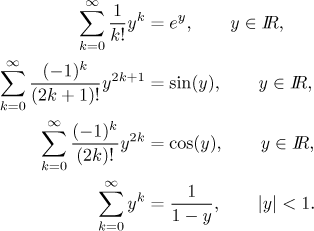
We are given a function series
The more series we know to start with, the better our chances to succeed, but usually the starting points are these four.

It is also good to know series for logarithm.
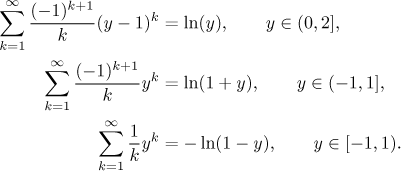
However, one can do without them, in case you are willing to work more: Such series can be transformed to geometric expansions using derivative.
Algorithm:
The procedure starts by writing an equality, where on one side you put the
given series and on the other side you put the symbol
The are two things one usually has to do.
Step 1. The parts of fk that feature x
should be written as

Note that in the last example we offered two possibilities, since one can
try to fit this series also to the series for cosine. Whether this is a good
idea or not depends on the coefficient ak. If we
can transform it so that the factorials
Step 2.
The coefficients should be fixed so that they have the right form. There are
five basic operations one can use.
• If the coefficients have the form of sum, the series can be split in
two.
• Unwanted constants that do not depend on k can be factored
out.
• Expressions Ak can be included in the x
part.
• Expressions like k, k + 1 etc. in the denominator
can be removed when you differentiate the series - but you have to fix the
power at the x part properly, we learned in Step 1 how to shift it.
For instance, if you want to remove k − 1 from the
denominator, you have to first fix the x group so that it has the form
• Expressions like k, k + 1 etc in the numerator
can be removed when you integrate the series - but again you have to fix the
power at the x part. For instance, if you want to remove
k − 1 from the numerator, you have to first fix the x
group so that it has the form
There is no reasonable way to remove/add factorials, so if they appear in
the given series, they pretty much determine which way we should go - note
that the above four series have different kinds of factorials.
Step 3. When the series has the right form, one has to make sure that indexing actually starts at the right place, the subtract/add trick is used for it (see Manipulating (power) series in Methods Survey - Series of functions).
Notation: There are essentially two ways in which to proceed. There
is a general way, the one described above, when you start with the basic
equality featuring the given series on one side and
We will now show an example. It is a bit beastly, since we wanted to show what can be done. For more reasonable examples see Solved Problems - Series of functions.
Example: Find the sum of the series

Since there are no factorials, there is no way to change this series into a series for the exponential, sine, or cosine. Thus we will try to make it look like the geometric series, we will use the general notation with f discussed above. First we get rid of the 3 in the power, then we move the term 8k into the x-part.
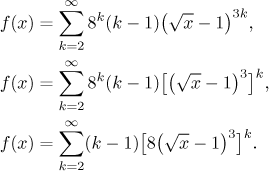
Now we need to get rid of k − 1, so we prepare the appropriate power and integrate.

We see that we cannot figure out the integral on the right, so we have to go back a bit and prepare the series more carefully. We put in some terms that will allow us to use the natural substitution for integrating.
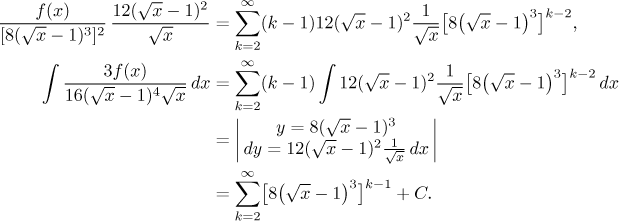
Now we again fix the power in the x-term and then apply the factoring out trick that makes the indexing of a geometric series start from 0. Then we can use the geometric expansion.
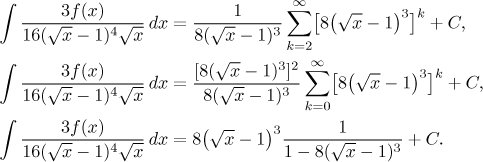
Note that this geometric expansion is true only if the term that was taken to power k is less than 1 in absolute value. This will determine the validity of the result. Now it remains to solve for f.
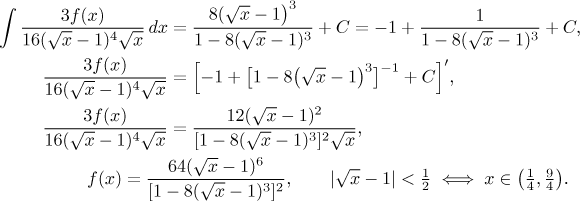
By the way, on the first line we did this: We denoted the whole third power as A, then we used my favorite add-subtract trick.
![]()
Remark: Of course, for many series these tricks do not help at all. Sometimes they do work to give a nice series, but trouble starts later, when solving for f. As an example we briefly show one deceptively simple series that we would really like to sum up.
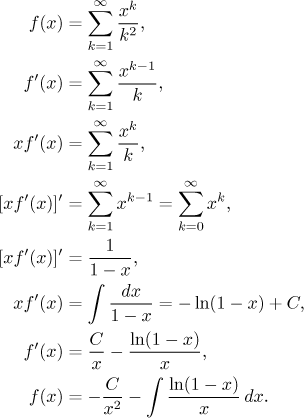
And that is the end of the road, we do not know how to explicitly express the integral on the last line.
Expanding in Fourier series
Back to Methods Survey - Series
of functions